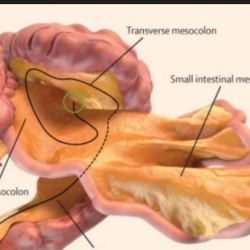
If you're working at a DMV office, you'd better get busy. The old organ donor cards just aren't going to cut it any more. We have a new organ. Instead of 78, the number is now 79. So, if someone comes in and wants to donate his or her mesentery, you will need to be prepared (1).
Also, these guys need to get to work, or at the very least, fix the title (2,3):

It must have taken real guts (sorry, that was pretty stupid) for J. Calvin Coffey, a professor of surgery at University of Limerick’s Medical School Ireland, to challenge 100 years of medical orthodoxy, but he did just that. In a paper entitled “The mesentery: structure, function, and role in disease,” which was published in Lancet Gastroenterology & Hepatology, Coffey reported that “distinctive anatomical and functional features have been revealed that justify designation of the mesentery as an organ.”
Coffey's description of the new kid on the block is not necessarily user-friendly:
"The mesentery distal to the duodenojejunal flexure is a contiguous and extraretroperitoneal organ."
English translation:
- Duodenojejunal flexure: the border between the duodenum and the jejunum
- Contiguous: Touching, or sharing a common border
- Extraretroperitoneal: Outside of the peritoneal cavity.
- Peritoneal cavity: The space within the abdomen that contains the intestines, the stomach, and the liver. It is bound by thin membranes.
What is the significance of the discovery? Coffey explained to the International Business Times: “This is relevant universally as it affects all of us. Up to now there was no such field as mesenteric science. Now we have established anatomy and the structure. The next step is the function. If you understand the function you can identify abnormal function, and then you have disease. Put them all together and you have the field of mesenteric science…the basis for a whole new area of science.”
Coffey describes the function of the mesentery, and it sounds rather important: "The mesentery suspends much of the intestines from the posterior abdominal wall, preventing it from collapsing into the pelvis when standing upright. Intestinal transit would probably be slowed or possibly even cease without this attachment."
This discovery could have multiple implications. As Coffey explained to CNN, "For doctors, it provides us with an opportunity to refresh our approach to many diseases such as inflammatory bowel disease and others...[t]his could help in identifying the mechanisms underlying these conditions and help us in unraveling their cause and how they develop."
It is not often that one overturns the science of anatomy. It is so infrequent that the time interval just happens to coincide with the Cubs winning the World Series prior to last year—108 years.
For Coffey, this wasn't just another day at the orifice office.
Notes
(1) The mesentery isn't exactly "new." It has been there all along, but was not designated as a separate organ.
(2) The book is being updated.
(3) No, I do not know what that thing on the cover that looks like a flying salad is.
Original citation: Coffey, J. Lancet Gastroenterology & Hepatology Volume 1, No. 3, p238–247, November 2016
